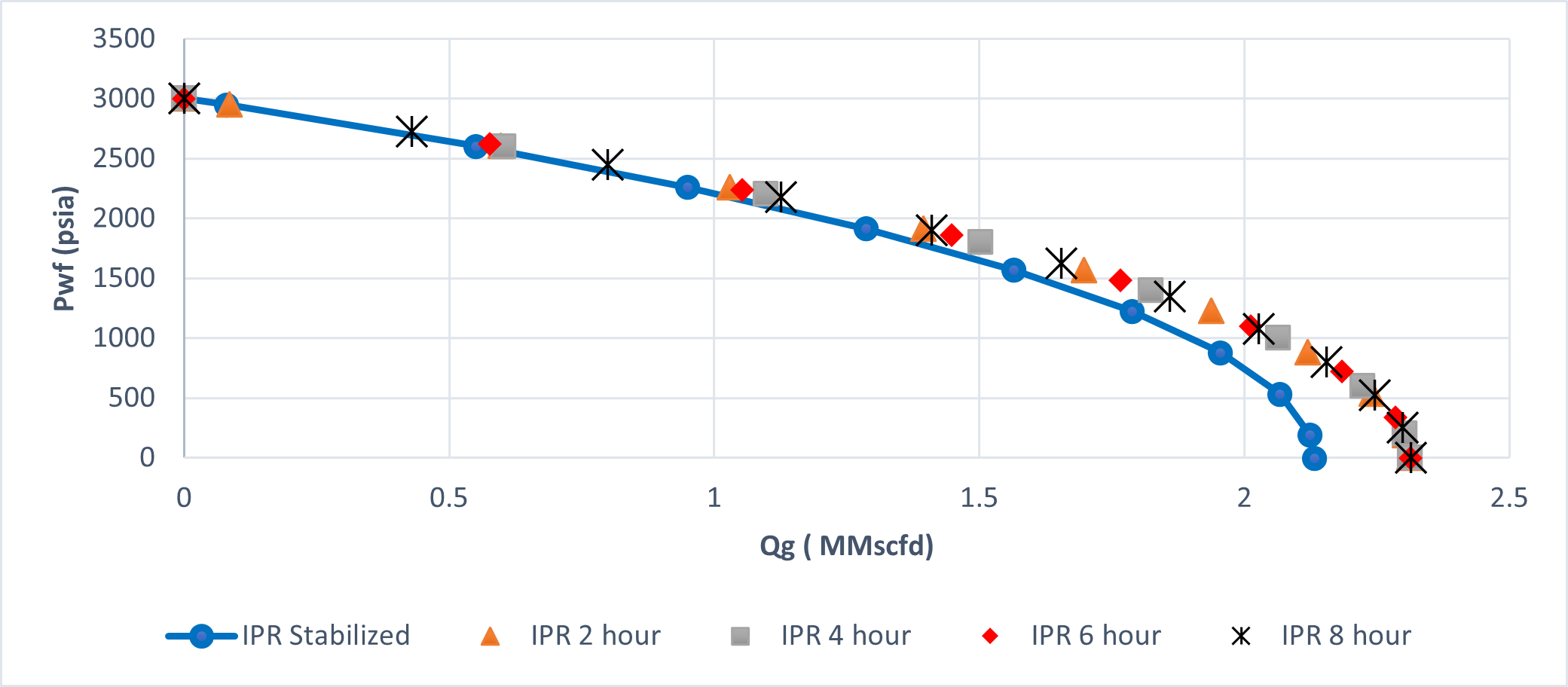A Deliverability Method for Estimating Stabilized Gas Well Performance during Transient Periods on Unconventional Reservoir
Abstract
This study discusses the determination of the stabilized flow coefficient, C, in the Rawlins and Schellhardt equation. It is applicable in the reservoir with low porosity and permeability model, usually found in unconventional reservoirs. In determining the flow coefficient, a deliverability test method proposed by Hashem and Kazemi was used during the transient flow period of a gas well. Besides, in determining the deliverability exponent, n, used in the least squared analysis equation derived by Johnston and Lee in the determination of C stabilized so that from each value of n, there will be supporting data for determining stabilized flow coefficient. Finally, the application and previous method will determine the flow coefficient value based on reservoir model time stabilization. Later it compares with the John Lee equation and IPR constructs from the model and John Lee.
Full text article
References
Acquah-Andoh, E., Putra, H. A., Ifelebuegu, A. O., & Owusu, A. (2019). Coalbed methane development in Indonesia: Design and economic analysis of upstream petroleum fiscal policy. Energy Policy, 131, 155–167. https://doi.org/10.1016/j.enpol.2019.04.035 DOI: https://doi.org/10.1016/j.enpol.2019.04.035
Al-Attar, H., & Al-Zuhair, S. (2008). A general approach for deliverability calculations of gas wells. Society of Petroleum Engineers - North Africa Technical Conference and Exhibition 2008: “Exploration and Production Challenges in North Africa,” 46–56. https://doi.org/10.2118/111380-ms DOI: https://doi.org/10.2118/111380-MS
Al-Hussainy, R., & Ramey, H. J. (1966). Application of Real Gas Flow Theory to Well Testing and Deliverability Forecasting. Journal of Petroleum Technology, 18(05), 637–642. https://doi.org/10.2118/1243-b-pa DOI: https://doi.org/10.2118/1243-B-PA
Bakshi, V., Fulford, N., Pereira, R., Davies, J., Delic, S., Morrissey, J., Anderson, S., Darowski, M., Lillie, A., Titus, E., Failat, Y. A., Bassett, R. A., Eacott, S., Fan, B., & Dutton, J. (2017). Shale Gas: A Practitioner’s Guide to Shale Gas and Other Unconventional Resources (V. Bakshi (ed.); 2nd ed.). Globe Law and Business Limited.
Chase, R. W., & Anthony, T. M. (1988). Simplified method for determining gas-well deliverability. SPE Reservoir Engineering, 3(3), 1090–1096. https://doi.org/10.2118/14507-pa DOI: https://doi.org/10.2118/14507-PA
Dashtgard, S. E., Buschkuehle, M. B. E., Fairgrieve, B., & Berhane, H. (2008). Geological characterization and potential for carbon dioxide (CO2) enhanced oil recovery in the Cardium Formation, central Pembina Field, Alberta. Bulletin of Canadian Petroleum Geology, 56(2), 147–164. https://doi.org/10.2113/gscpgbull.56.2.147 DOI: https://doi.org/10.2113/gscpgbull.56.2.147
Guo, K., Li, H., & Yu, Z. (2016). In-situ heavy and extra-heavy oil recovery: A review. In Fuel (Vol. 185, pp. 886–902). Elsevier Ltd. https://doi.org/10.1016/j.fuel.2016.08.047 DOI: https://doi.org/10.1016/j.fuel.2016.08.047
Hashem, Y. K. S., & Kazemi, H. (1996, April 28). Reservoir Properties and Stabilized Gas Well Performance From Short Deliverability Tests. The SPE Gas Technology Symposium. https://doi.org/10.2118/35618-MS DOI: https://doi.org/10.2118/35618-MS
Hidayat, F. (2016). Aplikasi Kurva Derivative Dalam Penentuan Batas Reservoir Pada Sistem Reservoir Lensa. Journal Of Earth Energy Engineering, 5(1), 28–41. https://doi.org/10.22549/jeee.v5i1.458 DOI: https://doi.org/10.22549/jeee.v5i1.458
Holditch, S. A. (2006). Tight Gas Sands. Journal of Petroleum Technology, 58(06), 86–93. https://doi.org/10.2118/103356-jpt DOI: https://doi.org/10.2118/103356-JPT
Johnston, J. E., Lee, W. J., & Blasingame, T. A. (1991). Estimating the stabilized deliverability of a gas well using the Rawlins and Schellhardt method. An analytical approach. Proceedings - SPE Eastern Regional Conference and Exhibition, 253–260. https://doi.org/10.2118/23440-ms DOI: https://doi.org/10.2118/23440-MS
Moridis, G., Collett, T., Boswell, R., Kurihara, M., Reagan, M., Koh, C., & Sloan, E. (2009). Toward Production From Gas Hydrates: Current Status, Assessment of Resources, and Simulation-Based Evaluation of Technology and Potential. SPE Reservoir Evaluation & Engineering, 12(5), 745–771. https://doi.org/10.2118/114163-PA DOI: https://doi.org/10.2118/114163-PA
Rawlins, E. L., & Schellhardt, M. A. (1986). Back-pressure data on natural gas wells and their application to production practices. In Oxford University: Vol. XXX. Lord Baltimore Press.
Spivey, J. P., & Lee, W. J. (2013). Applied Well Test Interpretation. In Society of Petroleum Engineers (SPE Textbo, Vol. 13, Issue 9). Society of Petroleum Engineers.
Suranto, A. M. (2016). Perbandingan Kinerja Reservoir Gas Konvensional dengan Coal Bed Methane (CBM). Journal of Earth Energy Engineering, 5(1), 1–10. https://doi.org/10.22549/jeee.v5i1.461 DOI: https://doi.org/10.22549/jeee.v5i1.461
Zhao, C., Li, J., & Zhang, H. (2019). Analysis of deliverability data in shale gas reservoirs: pseudo-pressure and pressure employed. Geosystem Engineering, 22(4), 225–231. https://doi.org/10.1080/12269328.2019.1583138 DOI: https://doi.org/10.1080/12269328.2019.1583138
Authors
This is an open access journal which means that all content is freely available without charge to the user or his/her institution. The copyright in the text of individual articles (including research articles, opinion articles, and abstracts) is the property of their respective authors, subject to a Creative Commons CC-BY-SA licence granted to all others. JEEE allows the author(s) to hold the copyright without restrictions and allows the author to retain publishing rights without restrictions.




